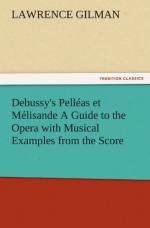XI. VENGEANCE
[Illustration: Anime, un peu retenu]
This is repeated still more vehemently three measures further on, and there is a return of the Fate motive as Melisande, at the bidding of Golaud, goes forth to seek the missing ring. An interlude, in which are blended the variant of the Melisande theme, which denotes her grieving, and the shimmering figure in sixteenth-notes heard during the dialogue at the fountain, leads into the scene before the grotto.
As Pelleas and Melisande stand in the darkness of the cavern we hear again (page 110, measure 2) the variant of the Fate motive which marked the close of the preceding scene; then, as a sudden shaft of moonlight illuminates the grotto, it is expanded and transmuted into a gleaming flood of orchestral and harmonic color (two flutes, oboe, two harps glissando, string tremolos, cymbals pp). While they talk of the beggars sleeping in a corner of the cave, an oboe and flute trace a tenuous and melancholy phrase (doux et triste) which continues almost to the end of the scene; it leads into a quiet coda formed out of the theme of Fate.
ACT III
After several bars of preluding by flute, harp, violas, and ’cellos (harmonics), on an arpeggio figure, ppp, flutes and oboe present (page 115, measure 6) a theme which, in an ampler version, dominates the entire scene. Its complete form, in which I conceive it to be suggestive of the magic of night, is as follows (page 118, measure 2):
XII. NIGHT
[Illustration: Modere sans lenteur]
It continues in the orchestra until, as Pelleas urges Melisande to lean further out of the window that he may see her hair unbound, a new theme enters, seeming to characterize the ardor of Pelleas’ mood (page 120, measure 3[9]):
[9] I quote it as it appears in its maturer form on page 125 (measure 3).
XIII. ARDOR
[Illustration: Animez toujours]
As Melisande leans further and further out of her window, these two themes (Night and Ardor) grow increasingly insistent. They are interrupted at Pelleas’ words, “I see only the branches of the willow drooping over the wall,” by a rich passage for divided violins, violas, and ’cellos (page 124, measure 3), and by a brief phrase to which attention should be drawn because of its essentially Debussy-like quality—the progression in the first measure of page 125 (scored for violins and violas). Then suddenly Melisande’s unloosed hair streams down from the open window and envelops Pelleas, and we hear (a famous passage) in the strings alone, ff, a precipitate descending series of seventh-chords built on the familiar whole-tone scale which Debussy finds so impelling (page 127, measure 1).




